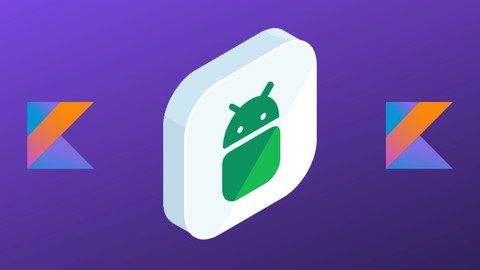
The Art of Doing: Dive Into Android Development with Kotlin
The Art of Doing: Dive Into Android Development with Kotlin, available at $64.99, has an average rating of 4.8, with 84 lectures, based on 182 reviews, and has 17676 subscribers.
You will learn about How to create your own Android applications using Android Studio and the Kotlin programming language. How to test and upload your applications on your own physical/emulated devices. How to design app layouts using linear and constraint layouts. How to use binding objects (view binding and data binding) to improve projects. How to implement navigation and fragments into your applications to have dynamic apps. How to implement view models and live data. We will create 6 full fledge application as well as many more "learning" applications throughout the course. This course is ideal for individuals who are Beginner Android students looking to understand Android application development with Kotlin. or Students who have gained an introductory level knowledge in another language (Python, JavaScript, etc..) and are looking for ways to apply their knowledge. or Anyone interested in learning! It is particularly useful for Beginner Android students looking to understand Android application development with Kotlin. or Students who have gained an introductory level knowledge in another language (Python, JavaScript, etc..) and are looking for ways to apply their knowledge. or Anyone interested in learning!.
Enroll now: The Art of Doing: Dive Into Android Development with Kotlin
Summary
Title: The Art of Doing: Dive Into Android Development with Kotlin
Price: $64.99
Average Rating: 4.8
Number of Lectures: 84
Number of Published Lectures: 84
Number of Curriculum Items: 84
Number of Published Curriculum Objects: 84
Original Price: $199.99
Quality Status: approved
Status: Live
What You Will Learn
- How to create your own Android applications using Android Studio and the Kotlin programming language.
- How to test and upload your applications on your own physical/emulated devices.
- How to design app layouts using linear and constraint layouts.
- How to use binding objects (view binding and data binding) to improve projects.
- How to implement navigation and fragments into your applications to have dynamic apps.
- How to implement view models and live data.
- We will create 6 full fledge application as well as many more "learning" applications throughout the course.
Who Should Attend
- Beginner Android students looking to understand Android application development with Kotlin.
- Students who have gained an introductory level knowledge in another language (Python, JavaScript, etc..) and are looking for ways to apply their knowledge.
- Anyone interested in learning!
Target Audiences
- Beginner Android students looking to understand Android application development with Kotlin.
- Students who have gained an introductory level knowledge in another language (Python, JavaScript, etc..) and are looking for ways to apply their knowledge.
- Anyone interested in learning!
-
Have you found yourself confused, lost, or frustrated when following complicated Android Studio guides, not fully understanding what was going on?
-
Have you always wanted to make your own mobile application but never new where to start?
-
Have you done some basics in another language like Python or JavaScript and don’t know where to apply your knowledge?
-
Are you looking to code in Kotlin, Google’s official language for Android application development?
If you’ve answered yes to any of the above then this course is for you! The Art of Doing: Dive Into Android Development with Kotlin is a course that takes the time to lay a foundation and build upon it. We won’t just get Android studio installed and rush through all it does for us in creating a project. Instead, we will walk through each file created and the given starter code, so you feel like you are in control of the applications you are writing! We’ll continue on this trend of fully explaining and gaining a mastery level understanding of concepts as we explore various views, layout styles, view and data binding, fragments and navigation, and lastly MVVM architecture.
I’m a self learner. I know what it is like to try to teach yourself a subject and be left following code someone else wrote but not fully understanding what you’ve done. I’ve gone through various tutorials, constantly asking myself “what does this line mean?”, “Why did they do that here?”, “How does this actually work?”. Those frustrations helped motivate me to create this course. While I may be a self taught programmer, I am a Master Teacher with a depth of experience in education. I know how to teach, how to relate high level concepts at a fundamental level, and what makes knowledge stick.
So often, when students ask for advice they are told to, “Go build something” or “Get involved on a project” but have no idea what projects to build or get involved in. This course will set you on your way! In this course I will walk you though, step by step, on how to to design the layout and the functionality of unique, engaging, and purposeful apps. By the end of this course, I promise that you will be coming up with your own app ideas and feel confident enough in your abilities to create them.
Together, we will work through 15 sections of this course. Each section will highlight concepts and ideas, explaining every step along the way and answering any questions you might have. I promise that you won’t experience any of the frustrations I had while learning because I know how important it is to not just introduce knowledge, but also to provide context for that knowledge to grow.
I’m sure there are other introductory courses out there that will try to teach you more…but I would imagine that the depth of knowledge in those courses is shallow. My goal for this course was not to expose you to every single concept or idea in android development but rather provide you with the structure and context to feel like you fully understand the fundamentals presented to you in this course.
Anyone can follow a guide and retype what someone else has already written. But by taking this course, I believe you will have the confidence, knowledge base, and ownership of knowledge such that you won’t have to follow someone else’s work, but rather create something from your own mind. After all, I believe the highest level of knowledge is creation.
After taking this course, based on the way I break down each topic and present the material, you will have a mastery level understanding of the fundamentals of Android Studio, Android app development, and the Kotlin programming language. I hope to see you in the class!
Course Curriculum
Chapter 1: Installation and Setup
Lecture 1: Course Preview
Lecture 2: Installation and Introduction
Lecture 3: Creating A Project
Lecture 4: Using A Virtual Device
Lecture 5: Using a Physical Device
Lecture 6: Links to Resources Used
Chapter 2: Exploring the Basics of Android Studio
Lecture 1: Exploring Android Studio
Lecture 2: Exploring the Manifest
Lecture 3: Exploring the Main Activity
Lecture 4: Exploring the Layout
Lecture 5: Exploring Lifecycle Methods
Chapter 3: The Linear Layout: A First Look
Lecture 1: Linear Layout Basics: View Width, Height, Sizing, and Spacing
Lecture 2: Linear Layout Basics: Nested Layouts and Layout Weight
Lecture 3: A Quick Note About Minimum SDK Targets
Chapter 4: Motivate Me App
Lecture 1: Motivate Me App Preview
Lecture 2: Building our Layout Part 1
Lecture 3: Building our Layout Part 2
Lecture 4: Writing Our Main Activity Part 1
Lecture 5: Writing Our Main Activity Part 2
Lecture 6: Writing Our Main Activity Part 3
Lecture 7: Writing Our Main Activity Part 4
Chapter 5: Counter App
Lecture 1: Counter App Preview
Lecture 2: Building Our Layout Part 1
Lecture 3: Building Our Layout Part 2
Lecture 4: Building Our Layout Part 3
Lecture 5: Writing Our Main Activity Part 1
Lecture 6: Writing Our Main Activity Part 2
Lecture 7: Writing Our Main Activity Part 3
Chapter 6: The Constraint Layout: A First Look
Lecture 1: Constraint Layout Basics 1
Lecture 2: Constraint Layout Basics 2
Lecture 3: Constraint Layout Basics 3
Chapter 7: Coin Flip App
Lecture 1: Coin Flip App Preview
Lecture 2: Building Our Layout Part 1
Lecture 3: Building Our Layout Part 2
Lecture 4: Building Our Layout Part 3
Lecture 5: Writing Our Main Activity Part 1
Lecture 6: Writing Our Main Activity Part 2
Lecture 7: Writing Our Main Activity Part 3
Chapter 8: Diaper Tracker App
Lecture 1: Diaper Tracker App Preview
Lecture 2: Building Our Layout Part 1
Lecture 3: Building Our Layout Part 2
Lecture 4: Building Our Layout Part 3
Lecture 5: Writing Our Main Activity Part 1
Lecture 6: Writing Our Main Activity Part 2
Chapter 9: Using onSaveInstanceState
Lecture 1: Shortcomings of our App
Lecture 2: onSaveInstanceState
Lecture 3: Shortcomings of onSaveInstanceState and Solutions
Chapter 10: ViewBinding
Lecture 1: Why Use Bindings?
Lecture 2: Motivate Me With View Binding Part 1
Lecture 3: Motivate Me With View Binding Part 2
Lecture 4: Counter App With View Binding Part 1
Lecture 5: Counter App With View Binding Part 2
Chapter 11: DataBinding
Lecture 1: Coin Flip with Data Binding Part 1
Lecture 2: Coin Flip with Data Binding Part 2
Lecture 3: Coin Flip with Data Binding Part 3
Lecture 4: Diaper Tracker with Data Binding Part 1
Lecture 5: Diaper Tracker with Data Binding Part 2
Chapter 12: Fragments and Navigation: A First Look
Lecture 1: What is a Fragment?
Lecture 2: Setting Up Multiple Fragments
Lecture 3: Enabling the Navigation Library
Lecture 4: Triggering Navigation Actions
Lecture 5: Passing Data to Fragments With Safe Args
Chapter 13: Score Keeper App
Lecture 1: Score Keeper App Preview
Lecture 2: Building Our Layout Part 1
Lecture 3: Building Our Layout Part 2
Lecture 4: Building Our Layout Part 3
Lecture 5: Building Our Layout Part 4
Lecture 6: Writing Our Kotlin Part 1
Lecture 7: Writing Our Kotlin Part 2
Lecture 8: Writing Our Kotlin Part 3
Chapter 14: View Models and Live Data: A First Look
Lecture 1: What is a View Model?
Lecture 2: Putting Data in a View Model
Lecture 3: Using Live Data and Observers
Lecture 4: Encapsulating Live Data
Lecture 5: Data Binding Live Data
Lecture 6: View Model Factories
Lecture 7: Wrapping Up View Models
Chapter 15: Click! The App
Lecture 1: Click! The App Preview
Lecture 2: Click! The App Part 1
Lecture 3: Click! The App Part 2
Lecture 4: Click! The App Part 3
Lecture 5: Click! The App Part 4
Lecture 6: Click! The App Part 5
Chapter 16: Thank You!
Lecture 1: Thank You For Completing This Course!!!
Instructors
-
Michael Eramo
Educator, Master Teacher, Self-Taught Programmer
Rating Distribution
- 1 stars: 1 votes
- 2 stars: 0 votes
- 3 stars: 9 votes
- 4 stars: 47 votes
- 5 stars: 125 votes
Frequently Asked Questions
How long do I have access to the course materials?
You can view and review the lecture materials indefinitely, like an on-demand channel.
Can I take my courses with me wherever I go?
Definitely! If you have an internet connection, courses on Udemy are available on any device at any time. If you don’t have an internet connection, some instructors also let their students download course lectures. That’s up to the instructor though, so make sure you get on their good side!
You may also like
- Top 10 Financial Technology Courses to Learn in December 2024
- Top 10 Agile Methodologies Courses to Learn in December 2024
- Top 10 Project Management Courses to Learn in December 2024
- Top 10 Leadership Skills Courses to Learn in December 2024
- Top 10 Public Speaking Courses to Learn in December 2024
- Top 10 Affiliate Marketing Courses to Learn in December 2024
- Top 10 Email Marketing Courses to Learn in December 2024
- Top 10 Social Media Management Courses to Learn in December 2024
- Top 10 SEO Optimization Courses to Learn in December 2024
- Top 10 Content Creation Courses to Learn in December 2024
- Top 10 Game Development Courses to Learn in December 2024
- Top 10 Software Testing Courses to Learn in December 2024
- Top 10 Big Data Courses to Learn in December 2024
- Top 10 Internet Of Things Courses to Learn in December 2024
- Top 10 Quantum Computing Courses to Learn in December 2024
- Top 10 Cloud Computing Courses to Learn in December 2024
- Top 10 3d Modeling Courses to Learn in December 2024
- Top 10 Mobile App Development Courses to Learn in December 2024
- Top 10 Graphic Design Courses to Learn in December 2024
- Top 10 Videography Courses to Learn in December 2024






















